User:Spartan7W/sandbox5
Appearance
Table of United States Presidents by military rank
[edit]| Rank order | Highest rank | Branch | President | Combat experience | Service notes |
|---|---|---|---|---|---|
| 1 |  General of the Armies of the United States |
Virginia militia |
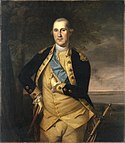 [1][2] |
French and Indian War (1754-1758) Revolutionary War (1775-1783) |
Served in the Virginia militia (1752–1758), attaining the rank of colonel; served as commander in chief of the Continental Army (1775–1783) during the Revolutionary War, with the rank of "General and Commander in Chief." Washington was a Lieutenant General in the United States Army at his death. In 1976, as part of the Bicentennial, then-president Gerald R. Ford posthumously appointed Washington as General of the Armies of the United States and specified that he would forever rank above all officers of the Army, past, present and future. The rank of General of the Armies is considered senior to General of the Army, and has been bestowed on only two officers in history, John J. Pershing, in 1919 for his services in World War I, and George Washington for his service as the first Commanding General of the United States Army. (An equivalent rank, Admiral of the Navy, was given to George Dewey.) |
| Rank order | Highest rank | Branch | President | Combat experience | Service notes |
|---|---|---|---|---|---|
| 2 |  General of the Army |
 (Regular army) |
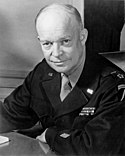 |
Supreme Commander of the Allied Invasion of Europe, primarily the Battles for Normandy, France and Germany World War II. | Graduated West Point; served 1915–1952. Served stateside during World War I and as Supreme Allied Commander during World War II. |
| Rank order | Highest rank | Branch | President | Combat experience | Service notes |
|---|---|---|---|---|---|
| 3 | General of the Army |
 (Regular Army) |
 |
Mexican–American War and Civil War | Graduated West Point; first Lieutenant General since Washington, appointed as four-star General of the Army in 1866. |
| Rank order | Highest rank | Branch | President | Combat experience | Service notes |
|---|---|---|---|---|---|
| 4 | Major General |
 North Carolina Militia Tennessee Militia |
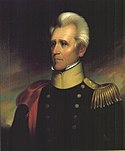 |
Revolutionary War, Creek War, War of 1812, First Seminole War. | Served at age 13 as a militia messenger during the Revolutionary War; was captured, becoming the only President to have been held as a prisoner of war (Washington had surrendered in the French and Indian War but was immediately paroled); served in the War of 1812, attaining the rank of major general and became a national hero after his success at the Battle of New Orleans. |
 |
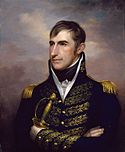 |
Northwest Indian War, War of 1812 | Dates of service: 1791–1798, 1812–1814. Became national hero after success at the Battle of the Thames. | ||
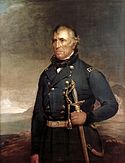 |
War of 1812, Black Hawk War, Second Seminole War, and Mexican–American War, | Became a national hero because of his achievements in the Mexican–American War. | |||
Brevet Major General of Volunteers |
 (volunteers) |
 |
American Civil War | Successful leadership in Virginia/West Virginia region; wounded at the Battle of South Mountain | |
Major General of Volunteers |
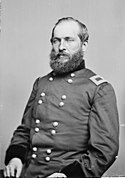 |
His heroic ride at the Battle of Chickamauga later helped him to be elected President. |
| Rank order | Highest rank | Branch | President | Combat experience | Service notes |
|---|---|---|---|---|---|
| 5 | Brigadier General |
 New Hampshire Militia |
 |
Mexican–American War | Served in New Hampshire Militia from 1831 to 1847 and attained the rank of Colonel. Appointed to command 9th Infantry Regiment during Army expansion for Mexican–American War. Subsequently promoted to Brigadier General and command of a brigade. |
New York State Militia |
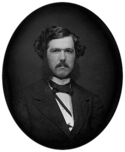 |
Inspector General of the New York Militia – Civil War |
Joined militia as Judge Advocate of 2nd Brigade. Appointed Quartermaster General on Governor's staff, and later appointed Inspector General. Offered command of brigade raised in New York City, but Governor declined to allow him to leave state service. Left service in 1863 after new Governor appointed a successor. | ||
 |
 |
Military Governor of Tennessee – Civil War |
Served in the 90th Regiment of Tennessee Militia in 1830s. Later appointed Colonel. | ||
 Indiana State Militia |
 |
Civil War | Battle of Perryville – Atlanta Campaign – Battle of Nashville |
| Rank order | Highest rank | Branch | President | Combat experience | Service notes |
|---|---|---|---|---|---|
| 6 | Colonel |
 Albemarle County |
 |
None | Like other Virginia gentlemen, he had militia duties, and did administrative work |
Orange County |
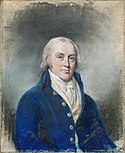 |
None | Left militia to enter Virginia legislature. (Some sources claim Madison briefly assumed command of an artillery battery during the British assault on Washington during the War of 1812. If true, he would join Washington (Whiskey Rebellion) as having seen military service as commander-in-chief.) | ||
Virginia State Militia |
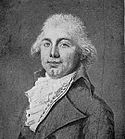 |
Revolutionary War | Dates of service: 1776–1779. Crossed the Delaware River with Washington (he is holding the flag in the famous painting); wounded in the Battle of Trenton. Returned to Virginia to recruit and lead a regiment as a militia Lieutenant Colonel, but the regiment was never raised. Commissioned as a Colonel during British invasion of Virginia in 1780 to command the militia raised in response and act as liaison to the Continental Army in North Carolina. Appointed As Secretary of State during the War of 1812, scouted and deployed troops during the British invasion of Washington. | ||
| Tennessee Militia |  |
None | Captain in a cavalry unit beginning in 1821. Subsequently appointed Colonel on staff of Governor William Carroll. | ||
 |
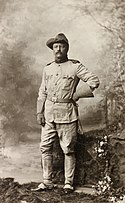 |
Spanish–American War – Medal of Honor (posthumously; 2001) |
Commissioned as a Second Lieutenant in the New York National Guard's 8th Regiment in 1882. Company commander with rank of Captain when he resigned in 1886. Famous for charge up San Juan Hill. Posthumously awarded the Medal of Honor. As ex-president, volunteered for service in World War I, but President Wilson declined. | ||
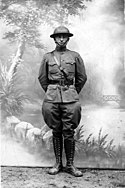 |
World War I | Served 1905–1911, then in World War I, 129th Field Artillery (1917–1919), Army Reserves (1919–1953)[3] |
| Rank order | Highest rank | Branch | President | Combat experience | Service notes |
|---|---|---|---|---|---|
| 7 |  |
 (Reserve) |
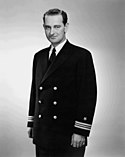 |
World War II – Silver Star |
Awarded Silver Star by General Douglas MacArthur for his role as an observer on a B-26 bomber mission.[4][5] (Controversial.).[6][7] |
 |
World War II | Served 1942–1945 on various islands in the South Pacific and Commanded SCAT units in the South Pacific.[8] |
| Rank order | Highest rank | Branch | President | Combat experience | Service notes |
|---|---|---|---|---|---|
| 8 |  Major |
New York State Militia |
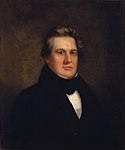 |
None | Years of service: 1820s–1830s, 1860s–1870s |
 Brevet Major |
 (volunteers) |
 |
Civil War | Served in the Army of the Potomac, originally with the 23rd Ohio Infantry same as President Rutherford B. Hayes. First major engagement in West Virginia in 1861 and was present at the surrender of the Army of Northern Virginia. | |
 Lieutenant Commander |
 (Reserve) |
 |
World War II | Years of service: 1942–1946. Served on USS Monterey. Earned 10 battle stars.[9][10] |
Captain/Lieutenant (naval)
[edit]| Rank order | Highest rank | Branch | President | Combat experience | Service notes |
|---|---|---|---|---|---|
| 9 |  Captain |
 |
 |
War of 1812 | Raised a company for the defense of Richmond in 1813 |
 |
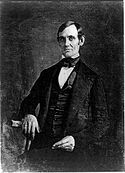 |
Black Hawk War | Initially elected to command a company as a Captain. Was mustered in and out of service during the Black Hawk War, going from Captain to Private and finishing his service in an independent spy company commanded by Captain Jacob Early. Honorably discharged without seeing combat. Also served in Stillman's Run and Battle of Kellogg's Grove. | ||
 (Reserve) |
 |
None | Served as a second lieutenant in the U.S. Army Reserve; served in the United States Army Air Forces during World War II, attaining the rank of captain. Was barred from combat because of poor eyesight. Narrated pre-flight training films under the Army Air Forces Motion Picture Unit. | ||
 Lieutenant |
 (Reserve) |
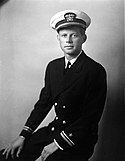 |
World War II – |
Commanded a PT boat. Earned Purple Heart and Navy and Marine Corps Medal for heroism in the PT-109 Incident.[11] | |
 |
None | Years of service: 1946–1953. Graduated 59th in class of 1946 out of 820, United States Naval Academy at Annapolis, Submarine service (Nuclear Specialist). Midshipman during World War II, served during Korean War, but never sent to Korea |
| Rank order | Highest rank | Branch | President | Combat experience | Service notes |
|---|---|---|---|---|---|
| 10 | |||||
 (Reserve) |
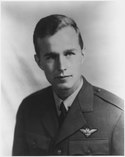 |
World War II | Second[12] youngest pilot in the United States Navy during World War II (Three days before turning 19).[13] Earned Distinguished Flying Cross. | ||
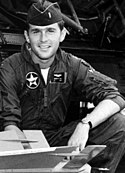 |
None | He performed Air National Guard duty as an F-102 pilot through April 1972, logging 336 hours, when he lost his authorization to be a pilot for failing to meet attendance and physical examination requirements.[14] He was later discharged eight months short of his six-year service requirement.[15] |
| Rank order | Highest rank | Branch | President | Combat experience | Service notes |
|---|---|---|---|---|---|
| 11 | Private |  New York State Militia |
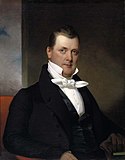 |
War of 1812 | Joined volunteer light dragoon unit and served in defense of Baltimore. Only future President with military service who did not serve as an officer. |
Did not serve
[edit]| President | Service notes |
|---|---|
| John Adams | None. Adams served as chairman of the Continental Congress's Board of War (1776–1777), making him the simultaneous equivalent of today's Secretary of Defense and Chairman of Senate Armed Services Committee. He did, however, take an active part in a naval battle against the British merchantman, Martha, on March 10, 1778; while in transit to France aboard the 24-gun frigate Boston. The ship's Captain, Samuel Tucker, later related the story that during the thick of the battle, he had discovered Adams "among my marines accoutered as one of them and in the act of defense."[16] |
| John Quincy Adams | None |
| Martin Van Buren | None |
| Grover Cleveland | None. He was drafted during the Civil War, but paid $150 for a substitute (a legal option under the terms of the Enrollment Act of 1863, and his substitute survived the war). |
| William Howard Taft | None. He was Secretary of War under President Theodore Roosevelt from 1904 to 1908. Taft also joined a Connecticut Home Guard unit during World War I. |
| Woodrow Wilson | None. Served as President during World War I. |
| Warren G. Harding | None |
| Calvin Coolidge | None |
| Herbert Hoover | None. He served in a private humanitarian capacity as a civilian in Europe during World War I. He was also involved in the Siege of Tientsin during the Boxer Rebellion as a guide for U.S. Marines. |
| Franklin D. Roosevelt | None. He attempted to join the Navy during the Spanish–American War but was unable as he contracted measles. Served as Assistant Secretary of the Navy from 1913 and through World War I; when the U.S. entered the war in 1917 he offered his resignation so that he could apply for a commission in the Navy, but was refused by the President. Witnessed fighting in World War I. In a post World War I publication "Harvard in the War" he is listed among the Harvard's contributors to World War I effort. He served as President during World War II. |
| Bill Clinton | None. He received a 2-A student draft deferment during the Vietnam War, and later registered for the draft. He received a high draft number, was not drafted and did not serve. He served as President during the peacekeeping war in Bosnia. |
| Barack Obama | None |
| Donald Trump | None |
References
[edit]- ^ wikisource:Public Law 94-479
- ^ wikisource:Order 31-3 Department of the Army Order Number 31-3 of 13 March 1978
- ^ "Military Personnel File of Harry S. Truman". Harry S. Truman Presidential Library and Museum. Retrieved January 1, 2009.
- ^ "American Warriors Home Page". americanwarriorsfivepresidents.com. Retrieved October 25, 2015.
- ^ Commander Lyndon B. Johnson, USNR from the Naval Historical Center
- ^ Caro, Robert (1982). The Years of Lyndon Johnson: The Path to Power. Alfred A. Knopf. ISBN 0-394-49973-5.
The most you can say about Lyndon Johnson and his Silver Star is that it is surely one of the most undeserved Silver Stars in history, because if you accept everything that he said, he was still in action for no more than 13 minutes and only as an observer. Men who flew many missions, brave men, never got a Silver Star.
- ^ Tillman, Barrett and Sakaida, Henry. "LBJ's Silver Star: The Mission That Never Was". b-26marauderarchive.org. Retrieved March 22, 2009.
The fact is LBJ never got within sight of Japanese forces.
{{cite web}}: CS1 maint: multiple names: authors list (link) - ^ Commander Richard M. Nixon, USNR from the Naval Historical Center
- ^ "CNN.com Specials". cnn.com. Retrieved October 25, 2015.
- ^ Lieutenant Commander Gerald R. Ford, USNR from the Naval Historical Center
- ^ Lieutenant John F. Kennedy, USN from the Naval Historical Center
- ^ Ryder, Robert Randall "My War Chuck Downey Youngest Naval Aviator in WWII." Sea Classics, August 2013. "Off he went for training in Memphis, Tenn., before heading to Pensacola, Fla., for flight school, where he was commissioned as an Ensign in the U.S. Navy on July 16, 1943. Downey was the tender age of 18 years, 11 months, and 14 days when he earned his wings."
- ^ "Democratic Group's Ad Revives "AWOL" Allegation Against Bush". FactCheck.org. Retrieved May 24, 2010.
- ^ Roane, Kit R. "Bush's military service in question – again (9/8/04)". USNews.com. Retrieved May 24, 2010.
- ^ McCullough, David (2001). John Adams. Simon & Schuster. p. 186. ISBN 978-1-4165-7588-7.
Of the part Adams had played in the action, Tucker was to speak warmly, and later confirm how, at the height of the fray, he had discovered Adams "among my marines accoutered as one of them and in the act of defense."
]











